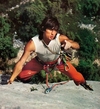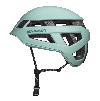Fred Rouhling, Salamandre and climbing extreme
Fred Rouhling. A name which evokes images of the utmost extreme, the intense, unrepeated or simply downright impossible. A name which from the second half of the ‘90’s onwards created an important chapter in climbing history, not just French, with routes at the complete physical limit, for some even beyond the limit. At times the style of the routes was deemed out of the ordinary, but it is perhaps because of this that they are, in some respects, completely genial. The prime example of all this is “Aikira”, the boulder-route which in 1995 took the world by storm with its tremendous grade: 9b. Unrepeated even today, Aikira heads an impressive list of first ascents which include, amongst others, “De l’autre coté du ciel”, “Hugh” and “Mandallaz Drive”, all three 9a with just a handful of repeats between them.
The Frenchman, born in 1970 and father of two children, has recently freed “Salamandre”, a completely natural 32m route at Saint-Pierre en Faucigny characterized by an incredible sequence (read dangerous) of two-finger and one-finger pockets. Fred spent a year training specifically for his new challenge, which he has now given an imprecise grade in the French climbing scale (i.e. 9 followed by a question mark). Perhaps to avoid past polemics, perhaps due to understandable uncertainty, or perhaps even to underline that, at the end of the day, it is not the grade that counts but the experience in itself. Who knows?
In this exclusive interview the eclectic Rouhling explains things from his point of view.
Fred, for Salamandre you put forward a grade 9?... Why a question mark instead of a letter?
It’s not that important really because grades should help us compare one route to the next. But when the rules are no longer respected and when the difficulties change from one crag to the next, grades lose their meaning. What counts is a general idea that one has about a specific route.
When you presented Salamandre you wrote that the 9th grade has by now become accepted – what do you mean by this?
Salamandre is one of those routes which are at the limit of what is humanly possible. The holds on these types of routes are so small, linking all the moves is touch and go and the weather conditions are extremely important.
How do you judge the difficulties of a route?
How long I need to climb it and how much other climbers have invested in attempting the line.
How would you describe the difficulties of Salamandre?
The main difficulties are connected to finger strength and the problem is getting hurt doing an extreme move on one of the two-finger or one-finger pockets.
Can you describe Salamandre to us and what makes it so difficult?
The route could certainly be graded 9 something even without the initial 8a/8a+ section. This is comprised of some long moves on small holds which resulted in me losing some sensitivity in my finger tips. Linking the crux was therefore horrible. To succeed I trained specifically at linking moves with numb fingers.
What is Fred Rouhling’s style?
I always want to do something new. A new problem, big moves, a dyno, tiny crimps, a “horrible” monodoigt… I’m attracted by all styles of climbing and I want to revel in the challenge of creating something new.
How much time and energy did you have to invest in freeing Salamandre?
I needed almost a year but in the meantime I also made the first ascent of some other routes, various grade 8 and two particularly difficult 8c’s.
Aikira 9b, dates back to 1995 but despite its age it has never been repeated. Do you know why? Do you think people are worried about proposing routes of this grade?
The route is truly difficult… there are 20 pure bouldering moves. I’m not sure if people are preoccupied with proposing routes this difficult, I have no idea.
In the past your routes raised many eyebrows, above all because of the grades. How important is it that other climbers repeat your routes?
I’m a climber of my generation who has fought to achieve the 9th grade and to climb routes with extreme boulder problems. The other climbers have a style which is very similar to each other, they use the same type of holds and bank on stamina.
How important is it to confront yourself with other climbers?
I climb for myself, I direct my life with my heart. This means that I do what I enjoy most, and I love freeing new routes.
And what about the route of your dreams?
It’s the next one!
| Planetmountain | |
| Hugh by Jolly Lamberti | |
| www | |
| www.fredrouhling.com | |
| www.fredmoix.com | |



 1 / 3
1 / 3
 Copia link
Copia link

 Fred Moix
Fred Moix






















